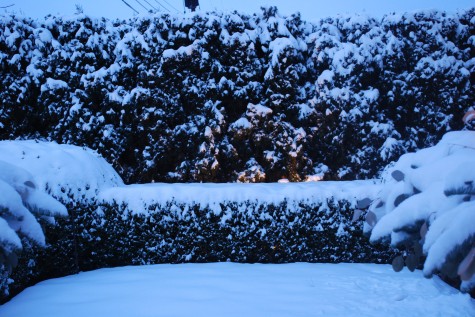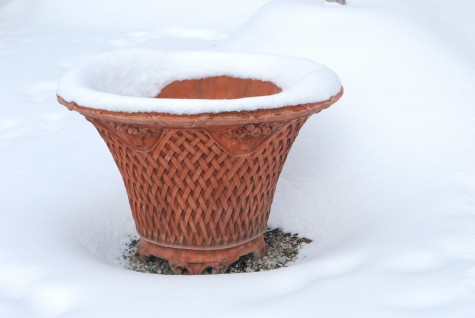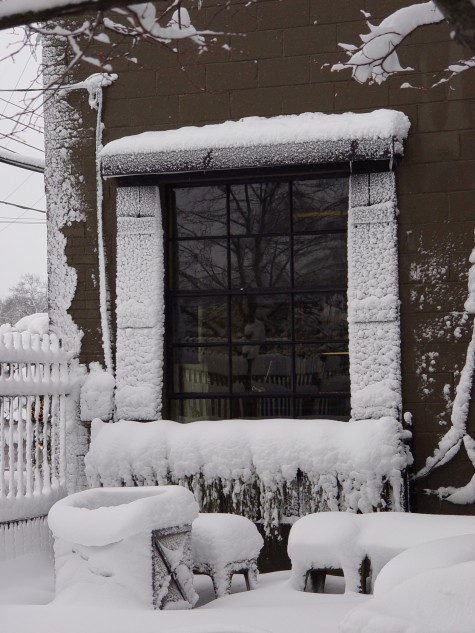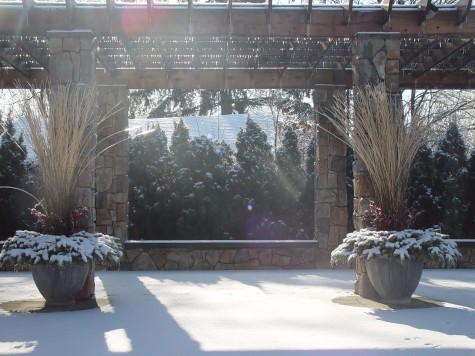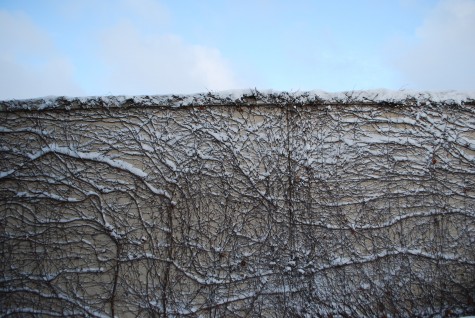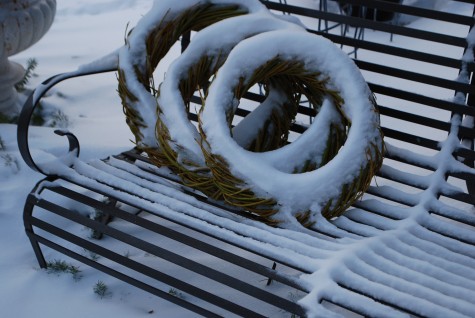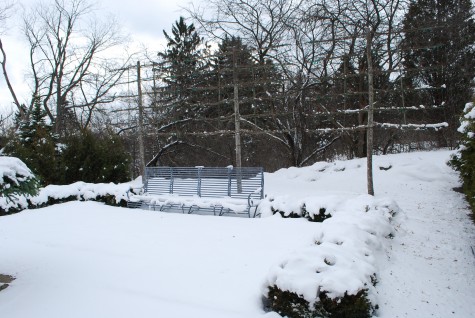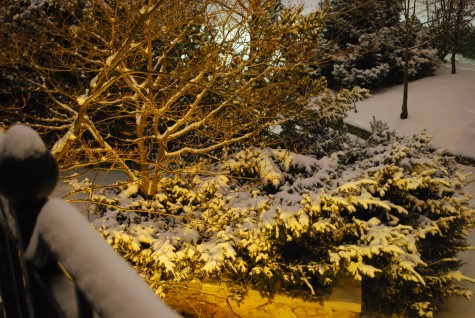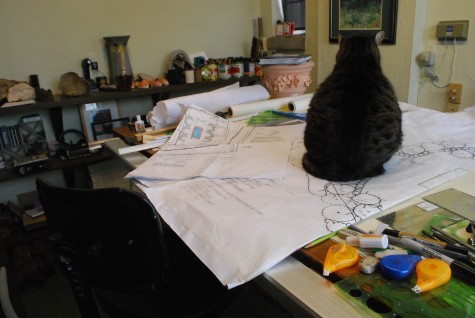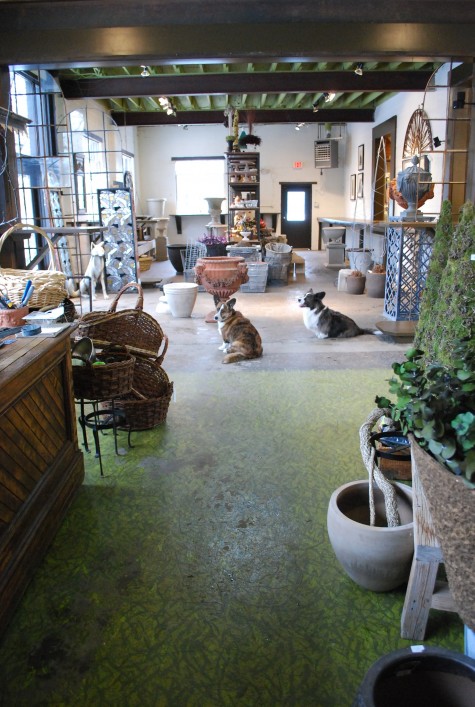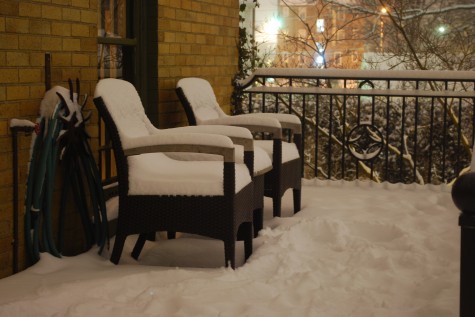Archives for January 2011
At A Glance: Structure
Structure
 Structure in a garden, whether formal or informal, symmetrical, or asymmetrical, visually subtle or strong, is a very important element of garden-making. A structure implies some element that is enduring. The most elaborate sand castle will wash away with high tide. Concrete that is not steel reinforced can crack. A house of cards can be blown over. Regularly, certain elements in my garden are blown over. The annuals last but one season. The hyssop peters out. Roses and lilacs without regular maintenance age, and fade. But those plants that provide structure-the evergreens, and the trees, endure, and grow to a great age. This boxwood rectangle with its boxwood balls at the corners was planted in 1997. It will be but 14 years old this year, but it has endured many changes of season, fungus, leaf miners, and heavy pruning. It provides structure to this garden-the rest of which changes every season. Tulips in the spring, annuals in the summer-the fall and winter have a still different look. The boxwood is a living architectural, structural, element. It provides the garden with a framework that makes a home for every other element. In 2005, a steel gloriette arrived from France; you see it pictured here. Still stuck in the roof, the gnarled remains of a giant wisteria. Like the wisteria and its gloriette, the spring tulips have a structural picture frame of boxwood that celebrate them.
Structure in a garden, whether formal or informal, symmetrical, or asymmetrical, visually subtle or strong, is a very important element of garden-making. A structure implies some element that is enduring. The most elaborate sand castle will wash away with high tide. Concrete that is not steel reinforced can crack. A house of cards can be blown over. Regularly, certain elements in my garden are blown over. The annuals last but one season. The hyssop peters out. Roses and lilacs without regular maintenance age, and fade. But those plants that provide structure-the evergreens, and the trees, endure, and grow to a great age. This boxwood rectangle with its boxwood balls at the corners was planted in 1997. It will be but 14 years old this year, but it has endured many changes of season, fungus, leaf miners, and heavy pruning. It provides structure to this garden-the rest of which changes every season. Tulips in the spring, annuals in the summer-the fall and winter have a still different look. The boxwood is a living architectural, structural, element. It provides the garden with a framework that makes a home for every other element. In 2005, a steel gloriette arrived from France; you see it pictured here. Still stuck in the roof, the gnarled remains of a giant wisteria. Like the wisteria and its gloriette, the spring tulips have a structural picture frame of boxwood that celebrate them.
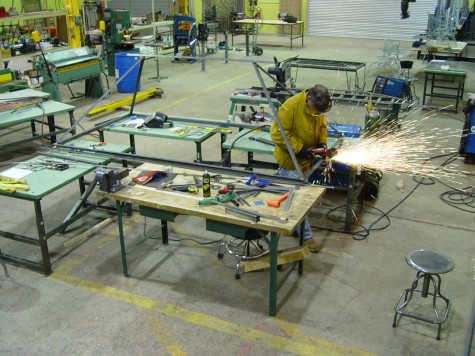
A gloriette provides shelter-as does a house for a family, a library for a reader, a road for a traveller, or a grocery store for a cook. I decided to build a gloriette, in an expanded dimension, for the shop. Buck obligingly drew one up in a retangular shape, and set immediately to making the roof. The angle iron pictured here is a stock steel shape. What he does with that angle iron is create a structure that will endure. Structural elements in gardens stand in stark contrast to what is ephemeral. Seasons come and go. Perennials thrive, and fade. As much as a garden is about change, and constant effort, more permanent elements provide comfort. The hedges I planted 15 years ago make me feel like my life as a gardener has meant something; what I did in my garden when I was 45 persists.
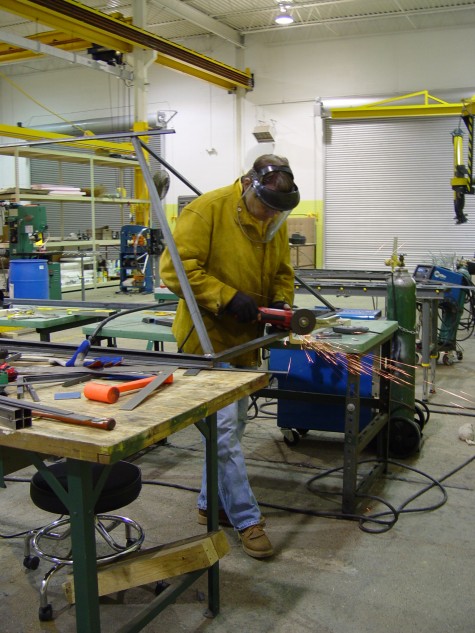 The gardens of my twenties and thirties do not exist anymore, but for the trees, and the evergreens. They have persisted in spite of an ownership without a gardener. The structure they provide still organize a property that is not much looked after. I regret that I gave that property up. The structure still in place-a comfort.
The gardens of my twenties and thirties do not exist anymore, but for the trees, and the evergreens. They have persisted in spite of an ownership without a gardener. The structure they provide still organize a property that is not much looked after. I regret that I gave that property up. The structure still in place-a comfort.
 Buck builds giant structures, with the help of a bridge crane. This single panel of the gloriette under construction dwarfs him. Plenty of structures both man-made and natural, make me feel the same way. The Grand Canyon, Yosemite, the Taj Mahal, the Washington Monument, the Lake Michigan dunes, the redwood forests-you get the picture. My house has been standing in the spot I now occupy- uninterrupted- since 1930. I like this. I very much like an idea bigger than me, a world view that makes me just a member of a big group-what gardener doesn’t?
Buck builds giant structures, with the help of a bridge crane. This single panel of the gloriette under construction dwarfs him. Plenty of structures both man-made and natural, make me feel the same way. The Grand Canyon, Yosemite, the Taj Mahal, the Washington Monument, the Lake Michigan dunes, the redwood forests-you get the picture. My house has been standing in the spot I now occupy- uninterrupted- since 1930. I like this. I very much like an idea bigger than me, a world view that makes me just a member of a big group-what gardener doesn’t?
 This modern version of my square French gloriette is long, and very tall. I imagined that anyone who might place it in their garden would want a home for climbing plants that would get them skyward where they want to be. I imagined they would want to walk underneath, and perhaps sit with a solid roof over their head. The Branch Studio has close to 30 foot tall ceilings-room enough to build a structure within a structure.
This modern version of my square French gloriette is long, and very tall. I imagined that anyone who might place it in their garden would want a home for climbing plants that would get them skyward where they want to be. I imagined they would want to walk underneath, and perhaps sit with a solid roof over their head. The Branch Studio has close to 30 foot tall ceilings-room enough to build a structure within a structure.
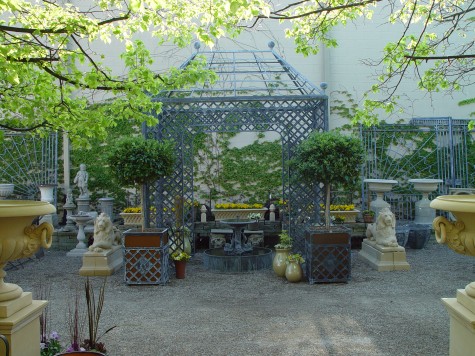 The first season I had the gloriette at the shop, we dressed it very formally, with associated tall lattice boxes, and an English lead fountain. Looking good, Buck. I so like how the lower branches of the shop lindens frame the roof of the gloriette. The woody structure and the steel structure overlap in a graceful way.
The first season I had the gloriette at the shop, we dressed it very formally, with associated tall lattice boxes, and an English lead fountain. Looking good, Buck. I so like how the lower branches of the shop lindens frame the roof of the gloriette. The woody structure and the steel structure overlap in a graceful way.
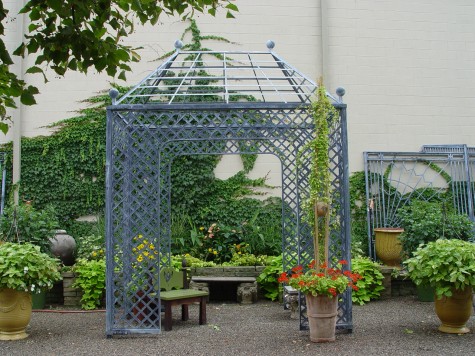 The second summer, we dressed the gloriette in a far less formal way. Rob’s Italian pot with a bamboo pole plant climber curved out with a wedged wood sphere-this is a great look. This treatment spoke up; we sold the gloriette.
The second summer, we dressed the gloriette in a far less formal way. Rob’s Italian pot with a bamboo pole plant climber curved out with a wedged wood sphere-this is a great look. This treatment spoke up; we sold the gloriette.
 My garden is actually quite handsome in the winter, for its green structure. I know there will be something there, once the snow melts. The gloriette likewise had considerable impact in the winter. The shadow on the wall behind it-so beautiful. Creating structure in a garden asks for everything. All of your thought. All of your effort. All of your history. All of your resources. This spring, gardeners everywhere will be buying beech trees. Trenching for hedges. Setting walkways. Installing fountains. Building gates, pergolas, and benches. Planning to provide structure. Are you ready?
My garden is actually quite handsome in the winter, for its green structure. I know there will be something there, once the snow melts. The gloriette likewise had considerable impact in the winter. The shadow on the wall behind it-so beautiful. Creating structure in a garden asks for everything. All of your thought. All of your effort. All of your history. All of your resources. This spring, gardeners everywhere will be buying beech trees. Trenching for hedges. Setting walkways. Installing fountains. Building gates, pergolas, and benches. Planning to provide structure. Are you ready?
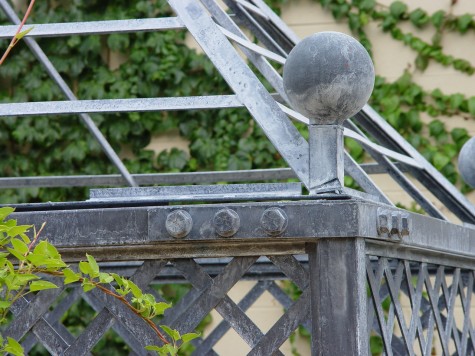
Every year I think about a cottage. Were I ever able to afford one, I would have no garden. I would move in, and do nothing outdoors except go there and look. In the woods, I would encourage the existing trees right up to and onto the foundation. Were I on the water, I would slog through the sand, and appreciate the reeds. Were I in the Smoky Mountains, I would put the smallest structure possible in a trillium field. If I ever had a cottage, what nature had in store for me would be more than enought to make me happy. Lacking a cottage on a wildly beautiful piece of property, my home landscape asks for structure. Steel and green. Sounds good to me.
Stuck
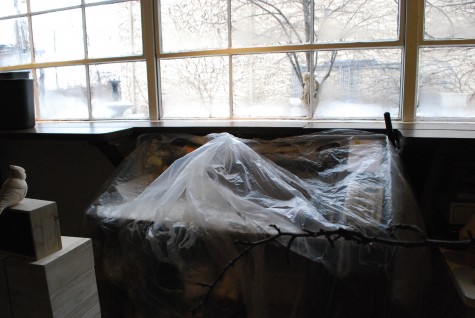 Stuck inside, that is. The inside story-we are repainting parts of Detroit Garden Works for the spring. Every square inch is torn up, everything is stacked up, on hold, or in storage. Then what we have has to be introduced to what is on the way for spring. The visit to the Atlanta Mart gave rise to plenty of ideas about display spaces. I walked through my shop rooms this past week, and tried to imagine what new spaces might look like. Not one idea surfaces. A bad cold didn’t help things. The January weather adds to the inertia that best describes winter; there is a sopping wet and partially frozen dingy grey wool blanket everywhere I look. Every square foot of our 10,000 square feet will be home to our the spring gardening congress. I know I need to be ready, but there needs to be a plan first. All the possibilities and sheer the size of this place means I have less time that I think to get it thought out. It is just hard to shake off that longing for another time and another place-like my garden in the spring or summer or fall- and get going. This makes for a design headache.
Stuck inside, that is. The inside story-we are repainting parts of Detroit Garden Works for the spring. Every square inch is torn up, everything is stacked up, on hold, or in storage. Then what we have has to be introduced to what is on the way for spring. The visit to the Atlanta Mart gave rise to plenty of ideas about display spaces. I walked through my shop rooms this past week, and tried to imagine what new spaces might look like. Not one idea surfaces. A bad cold didn’t help things. The January weather adds to the inertia that best describes winter; there is a sopping wet and partially frozen dingy grey wool blanket everywhere I look. Every square foot of our 10,000 square feet will be home to our the spring gardening congress. I know I need to be ready, but there needs to be a plan first. All the possibilities and sheer the size of this place means I have less time that I think to get it thought out. It is just hard to shake off that longing for another time and another place-like my garden in the spring or summer or fall- and get going. This makes for a design headache.
We have 2 containers coming from the Europe, the first of which is scheduled to make Montreal February 4. What happens next is anyone’s guess. Should that part of Canada see a snow storm the likes of which invaded New York City a few days ago, the railway will be shut down, or keep traffic moving at a crawl. A 2 day trip from Montreal might take 10 days. We have a customs broker who attends to the process of our container being cleared for entrance into the US. That process is a good deal more stringent and time consuming today than 10 years ago. I have no earthly idea what day that semi will pull in with that container on board. It could be days-it could be more time than I bargained for.
If you are a gardener, you get design headaches too, particular to the winter months. The process of deciding what trees, shrubs, perennials, groundcovers, annuals, tropicals, vegetables, herbs you are crazy for-easy. What we all have a mind to grow next season-easy. Every tomato under the sun looks good right about now. What we plan to change, renovate, turn around and rethink-easy. Putting all of this together in a coherent scheme-a design headache. Beautiful meadows-there are many that are nature driven and naturally maintained. They tend to be really big spaces-much bigger than my yard. When nature has an idea, she expresses it on a really big scale. A mini meadow requires such thoughtful design-there’s simply no room for mucking about with obviously unresolved areas. Full scheme ahead.
On my small property, in my small business, I do not have unlimited space and time. I need to pick and choose which statements I wish to make, and then decide how to make them. This means my gardening broadcasts need a lot of distillation, and fast. The Mart in Atlanta-so many things in one place. Making sense of it all-big work that is still going on. One finite space, one small voice-looking to organize and energize a collection. Seed catalogues, tools, nursery stock availability lists, annuals, pots and benches for spring-there is plenty to to see, read and absorb. There is also the matter of the stack of site plans on my drafting table-projects which need design time before spring.
Customers straggle to my door-we are happy to let the garden-starved in, but we do not provide that much comfort. The shop is just about 55 degrees. The most lively thing going on is the dogs barking. The January doldrums have set in. The shop is in so many fragments, waiting for an organizing metaphor. In spite of my headache, I like these days when every room is taken down to its bare bones, and the thought of putting it all back together scares me. It means I have work to do that I like.
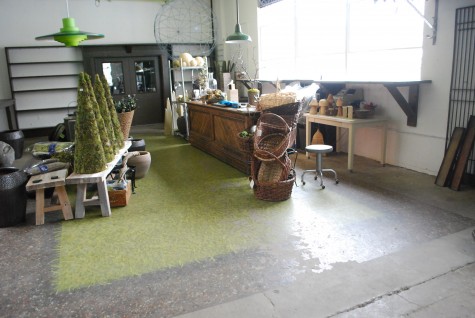 Sorry to say this, but we northern gardeners have the entire month of February, and perhaps into March to go before there is any hint of spring. Not so good for you-not so great for me either. I so miss my garden. But for the shop, the deconstruction is good. It means our spring will be a fresh.
Sorry to say this, but we northern gardeners have the entire month of February, and perhaps into March to go before there is any hint of spring. Not so good for you-not so great for me either. I so miss my garden. But for the shop, the deconstruction is good. It means our spring will be a fresh.  If there ever was a time for a big idea, this is it. I feel sure that if I look long enough, I’ll spot one.
If there ever was a time for a big idea, this is it. I feel sure that if I look long enough, I’ll spot one.
A Hot Spot For Cool Plants
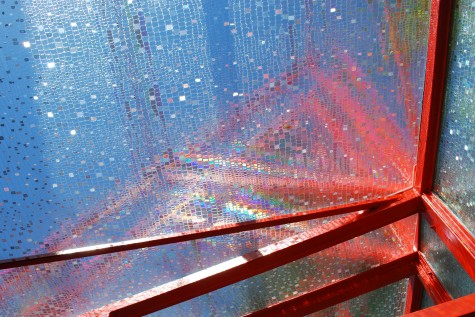 I have a client with a vision that defies description. Her vision well may be, is no doubt, visionary. I have a history with her that spans quite a few years, but I am never ready for what might come next with her. I have seen her collect the most amazing and esoteric objects-for both inside and out-and gone on to see her put it all together in a way that never crossed my mind. A few years ago she had the idea to roof a rear terrace. I was not prepared for a steel structure painted orange, and a dichroic glass roof. As I have since learned, dichroic glass is layered with metal oxides. Thus the sparkles that make for a little shade. Dichroic glass-very reflective. The roof, in no way symmetrical, in no way expected.
I have a client with a vision that defies description. Her vision well may be, is no doubt, visionary. I have a history with her that spans quite a few years, but I am never ready for what might come next with her. I have seen her collect the most amazing and esoteric objects-for both inside and out-and gone on to see her put it all together in a way that never crossed my mind. A few years ago she had the idea to roof a rear terrace. I was not prepared for a steel structure painted orange, and a dichroic glass roof. As I have since learned, dichroic glass is layered with metal oxides. Thus the sparkles that make for a little shade. Dichroic glass-very reflective. The roof, in no way symmetrical, in no way expected.
 It did not take long for her to have the idea to enclose the terrace with a roof space with glass walls. A conservatory, if you please. The upshot-a conservatory of the most un-conservatory sort you can imagine. New this winter-integral planter boxes made of marble. A very visually active and sassy marble. I went shopping for the plants. Whenever anyone says home greenhouse to me, I cringe. A working greenhouse is just that-lots and lots of work. Professionals manage this with a steely dedication. Most home greenhouses I have seen are neglected affairs. The remains of holiday pointsettias stashed under the bench. Struggling tropical plants. I would not recommend them to a home enthusiast, unless they promise to live in that space. Places you live in have a whole different feeling than places you visit. My basement is a good example. This conservatory space-a space in which to live.
It did not take long for her to have the idea to enclose the terrace with a roof space with glass walls. A conservatory, if you please. The upshot-a conservatory of the most un-conservatory sort you can imagine. New this winter-integral planter boxes made of marble. A very visually active and sassy marble. I went shopping for the plants. Whenever anyone says home greenhouse to me, I cringe. A working greenhouse is just that-lots and lots of work. Professionals manage this with a steely dedication. Most home greenhouses I have seen are neglected affairs. The remains of holiday pointsettias stashed under the bench. Struggling tropical plants. I would not recommend them to a home enthusiast, unless they promise to live in that space. Places you live in have a whole different feeling than places you visit. My basement is a good example. This conservatory space-a space in which to live.
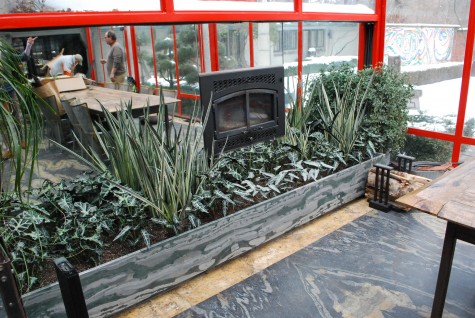 The orange steel structure, and the marble floor-what plants would I choose? The dichroic glass makes for more shade than you would think. A collection of black and silver alocasias-Black Velvet, Silver Arrow, and the very rare Alocasia Tigrina Superba seemed like a good idea. They are a supporting cast to a particularly beautiful sanseveria-Bantel’s Sensation. Sensational, indeed. Grey, green and black-much like the marble, and the cast iron fireplace.
The orange steel structure, and the marble floor-what plants would I choose? The dichroic glass makes for more shade than you would think. A collection of black and silver alocasias-Black Velvet, Silver Arrow, and the very rare Alocasia Tigrina Superba seemed like a good idea. They are a supporting cast to a particularly beautiful sanseveria-Bantel’s Sensation. Sensational, indeed. Grey, green and black-much like the marble, and the cast iron fireplace.
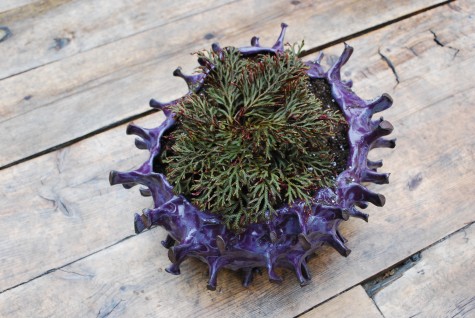 A fabulous purple glazed sea urchin shaped pot from my client looks all the better for a planting of Selaginella “Ruby Red”. Please note, It was not so easy to choose a plant for this partcular container. I have planted no end of green and lime selaginellas in pots-this variety is new to me. I am falling for it-hard. Little pots demand little growing plants. Some horticultural relationships are about the idea of an equality of contributon. As growing things never are at rest, a sensible start-little for little- makes for a reasonable approximation of equilibrium. This is a fancy way of saying, match your plants to their environment, and watch what will come of it.
A fabulous purple glazed sea urchin shaped pot from my client looks all the better for a planting of Selaginella “Ruby Red”. Please note, It was not so easy to choose a plant for this partcular container. I have planted no end of green and lime selaginellas in pots-this variety is new to me. I am falling for it-hard. Little pots demand little growing plants. Some horticultural relationships are about the idea of an equality of contributon. As growing things never are at rest, a sensible start-little for little- makes for a reasonable approximation of equilibrium. This is a fancy way of saying, match your plants to their environment, and watch what will come of it.
 My clients lives in the space-any chance they get. This entirely accounts for how compelling and lively a living space it is. She has created an environment that is warm, provocative, and compelling. I have been here to dinner on occasion-the room, the food, the music, and the conversation-magical. Even with the winter light, there is a sense of life that makes for liftoff. Some of the most interesting conversations I have ever had happened in this room. Make of this what you will.
My clients lives in the space-any chance they get. This entirely accounts for how compelling and lively a living space it is. She has created an environment that is warm, provocative, and compelling. I have been here to dinner on occasion-the room, the food, the music, and the conversation-magical. Even with the winter light, there is a sense of life that makes for liftoff. Some of the most interesting conversations I have ever had happened in this room. Make of this what you will.
 A second, and larger glazed sea urchin pot-I planted it solid with Escheveria Shaviana. Is this not a a happy relationship? The color relationships and similar textures-very happy. How do gardeners shop for plants? For the flowers? For the habit of the plant? For the hardiness? The designer in me shops for the visual relationships. My background in the science of horticulture saves me from foolish choices most of the time-but not all of the time.
A second, and larger glazed sea urchin pot-I planted it solid with Escheveria Shaviana. Is this not a a happy relationship? The color relationships and similar textures-very happy. How do gardeners shop for plants? For the flowers? For the habit of the plant? For the hardiness? The designer in me shops for the visual relationships. My background in the science of horticulture saves me from foolish choices most of the time-but not all of the time.
 Tillandsia Xerographica is a plant I had never seen before. They are strikingly silver grey. Before trying to plant this extraordinary space, I would not have given them a moment’s notice. This space-they belong. Tillandsias are bromeliads. They are commonly referred to as air plants. A plant you can lay on the table, which will thrive with a generous misting twice a week-astonishing.
Tillandsia Xerographica is a plant I had never seen before. They are strikingly silver grey. Before trying to plant this extraordinary space, I would not have given them a moment’s notice. This space-they belong. Tillandsias are bromeliads. They are commonly referred to as air plants. A plant you can lay on the table, which will thrive with a generous misting twice a week-astonishing.
 This space is incredibly beautiful-my pictures do it no justice. It is unlike how I think. It is unlike what I usually see. My client- she is a visionary girl.
This space is incredibly beautiful-my pictures do it no justice. It is unlike how I think. It is unlike what I usually see. My client- she is a visionary girl.
